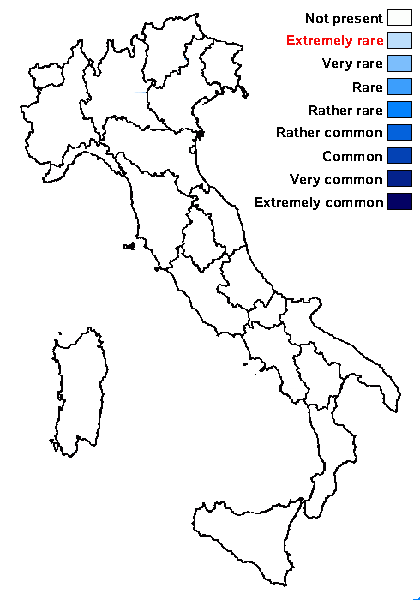Chaenothecopsis viridialba (Kremp.) A.F.W. Schmidt
Mitt. Staatsinst. Allg. Bot. Hamburg, 13: 143, 1970. Basionym: Calicium viridialbum Kremp. - Flora, 53, 30–31: 482, 1871 (1870)
Synonyms:
Distribution:
Description: Thallus inapparent, not lichenized. Apothecia pin-liked, stalked, 1-2 mm high, the stalk greyish white, 0.05-0.09 mm thick, pale in central part, consisting of periclinally arranged hyphae, the outer part aeruginose, with a whitish outermost layer of dead hyphae giving the stalk an uneven, pruina-like surface and a pale colour. Capitulum black, lenticular in young apothecia, but soon hemispherical to irregular, 0.2-0.3 mm across; mazaedium absent. Exciple poorly developed, forming a short collar at the base of the capitulum, 8-14 µm thick, consisting of 4-6 layers of periclinally arranged, reddish brown hyphae; epithecium thin, brownish; hypothecium of branched and intertwined hyphae, pale, but with varying amounts of a yellowish red pigment in lower part, 80-110 µm high. Asci 8-spored, cylindrical, with a thickened apex penetrated by a narrow canal, formed singly, persisting until the uniseriately arranged spores are mature. Ascospores 1-celled, brown, ellipsoid, 7-10 x 3-4 µm, with a distinctive minute ornamentation. Photobiont absent. Spot tests: all parts of the apothecium with a red pigment K+ aeruginose green. Chemistry: an unknown reddish pigment. Note: on bark and lignum of conifers and deciduous trees, often found together with Chaenotheca chrysocephala; widespread in the temperate zone of the Northern Hemisphere, with scattered records from the Alps (all outside Italian territory), where it is not common. To be looked for in the Italian Alps.
Growth form: Fungus
Substrata: bark and lignum
Reproductive strategy: mainly sexual

Predictive model
Growth form: Fungus
Substrata: bark and lignum
Reproductive strategy: mainly sexual

Predictive model
 INDEX FUNGORUM
INDEX FUNGORUM
 GBIF
GBIF


